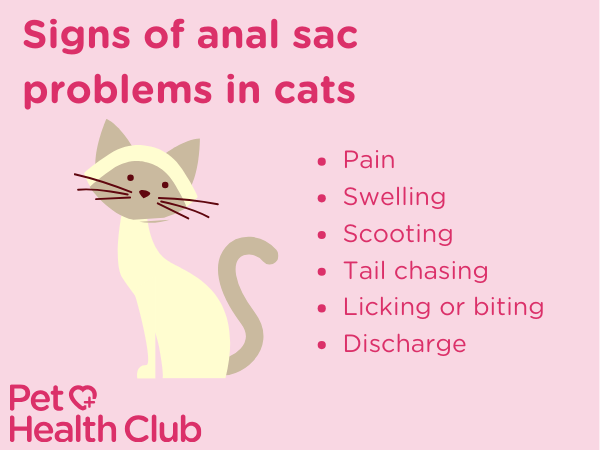Cat anal sac disorder: diagnosis, treatment and prevention
Okay, so it's not the nicest of subjects, but with anal sac or anal gland disorders being a reasonably common issue in cats, it's important to understand what they entail. We will help you to recognise the signs and symptoms of anal sac disease in cats.
What are anal sacs?
Cats have two anal sacs just inside their bottom, which produce a dark, smelly, oily liquid every time a poo is passed. The liquid is expressed onto the poo, and its strong scent helps to mark your cat's territory.
Sometimes called anal glands, the anal sacs are smaller than the size of a pea. They usually function normally, but problems can develop, and treatment may be necessary.
So, what are the common anal sac problems, and how do you spot the signs?
Common anal sac problems in cats
Your cat's anal glands can become infected, blocked up, or even develop an abscess. Here's an outline of the most common issues:
Impacted anal sacs
The most common anal sac problem in cats is caused by clogging or blockage to the duct or tube that's used to empty the sac. This can lead to a build-up of pressure and can cause pain. This can make it painful for your cat to poo and, therefore, could lead to constipation.
Anal sac infections
A build-up of bacteria in the anal sac can cause infection. Left untreated, this infection may cause an abscess, so it's vital to get your cat to the vet as quickly as possible.
Abscesses in the anal sac
The most painful of the three conditions, an abscess, is a swollen capsule of pus. These often burst, and you may see blood and pus around your cat's bottom. Abscesses will need to be flushed out and may need antibiotics.
Tumours
Very rarely, anal sac cancers can be seen, but this is much less likely than the above problems.
Recognising the signs and symptoms of anal gland problems in cats

Common signs of anal sac problems include:
- Pain: your cat may find it painful to poo or to sit down.
- Swelling: you may notice swelling on the sides of her bottom or be able to feel hard masses in this area. The anal sacs sit at the 4 and 8 o'clock position on your cat's bottom.
- Scooting: A common sign is to see your cat dragging their bottom along the ground.
- Tail chasing: they may reach for their tail more than usual.
- Licking or biting: they may repeatedly lick or bite the area around her tail and back end.
- Discharge: you may see or smell a smelly discharge from the back end, which may contain blood and/or pus.
If you spot any of these signs in your cat, visit your vet.
“A build-up of bacteria in the anal sac can cause infection. Left untreated, this infection may cause an abscess, so it’s vital to get your cat to the vet as quickly as possible.”
Treating anal sac disorders in cats
Treating anal sac disorders in cats normally requires more than one approach. These include:
- Resolving the immediate issue
- Managing any underlying causes
- Preventing future problems
Anal sac disorders can include impaction, infection, abscesses, and in rare cases, tumours. Here's an in-depth look at how these conditions are treated:
Initial Examination
Treatment begins with a thorough examination by your vet. They'll check your cat's anal sacs to determine the specific problem—whether it's impaction (where the sacs are full but can't empty), infection, or an abscess (a more severe infection that's led to the formation of a pus-filled lump). If a tumour is suspected, further diagnostic steps will be necessary.
Treatment of impaction
Manual expression
The most common treatment for impaction is the manual expression of the anal sacs. Your vet will gently squeeze the sacs to expel their contents. Your vet can do this, and while it might be uncomfortable for your cat, it provides immediate relief. If this process is too uncomfortable for your cat, or the glands are very impacted, your vet may recommend that your cat be sedated so they can be flushed.
Dietary changes
Increasing fibre in your cat's diet can help create bulkier, firmer stools, which can help naturally express the anal sacs when your cat defecates.
Treatment of infections
Antibiotics
If the anal sacs are infected, your vet will prescribe antibiotics. These may be given orally or, in some cases, infused directly into the anal sacs.
Anti-inflammatories
Medications to reduce inflammation and pain may also be prescribed to make your cat more comfortable during recovery.
Regular expression
While treating an infection, your vet may recommend regular expressions of the sacs to keep them empty and allow them to heal.
Treatment of abscesses
Flushing
An abscess may require flushing under sedation or general anaesthesia.
Antibiotics and pain relief
Like with infections, antibiotics will be used to treat the underlying bacterial cause, and pain relief will be provided to help manage your cat's discomfort.
Treatment of tumours
Biopsy and diagnosis
If a tumour is suspected, a biopsy will be taken for analysis. The treatment plan will depend on the type of tumour and whether it's benign or malignant.
Surgical removal
In many cases, the recommended treatment will be surgical removal of the tumour, usually along with the affected anal sac(s).
Additional therapy
For malignant tumours, additional treatments such as chemotherapy or radiation therapy may be considered based on your cat's specific situation and overall health.
Aftercare and prevention
Diet and hydration
Ensuring your cat has a high-fibre diet and stays well-hydrated can help maintain regular bowel movements and reduce the risk of future impactions.
Regular vet check-ups
Regular examinations can help catch any recurrence early. Your vet may also show you how to check your cat's anal sacs at home and express them if necessary, although this is not recommended without proper training. Overexpression of the glands can lead to inflammation and further problems, so glands should only be expressed when necessary rather than as a routine event.
Weight management
Overweight cats are at higher risk for anal sac disorders, so keeping your cat at a healthy weight can help prevent problems.
Monitoring
After treatment, it's crucial to monitor your cat for signs of recurrence, such as scooting, excessive licking of the anal area, or signs of discomfort. Prompt attention to these signs can help catch and address any issues early.
Treating anal sac disorders in cats involves a combination of direct treatment of the current condition and strategies to prevent future problems. With proper veterinary care and management, most cats can recover from these uncomfortable conditions and go on to live happy, healthy lives.
Need advice on anal gland problems in cats?
For expert advice on anal sac problems in cats, get in touch with your local vet. Find your nearest vet using our Find a Vet page, or speak to a vet online using Online Vets.




